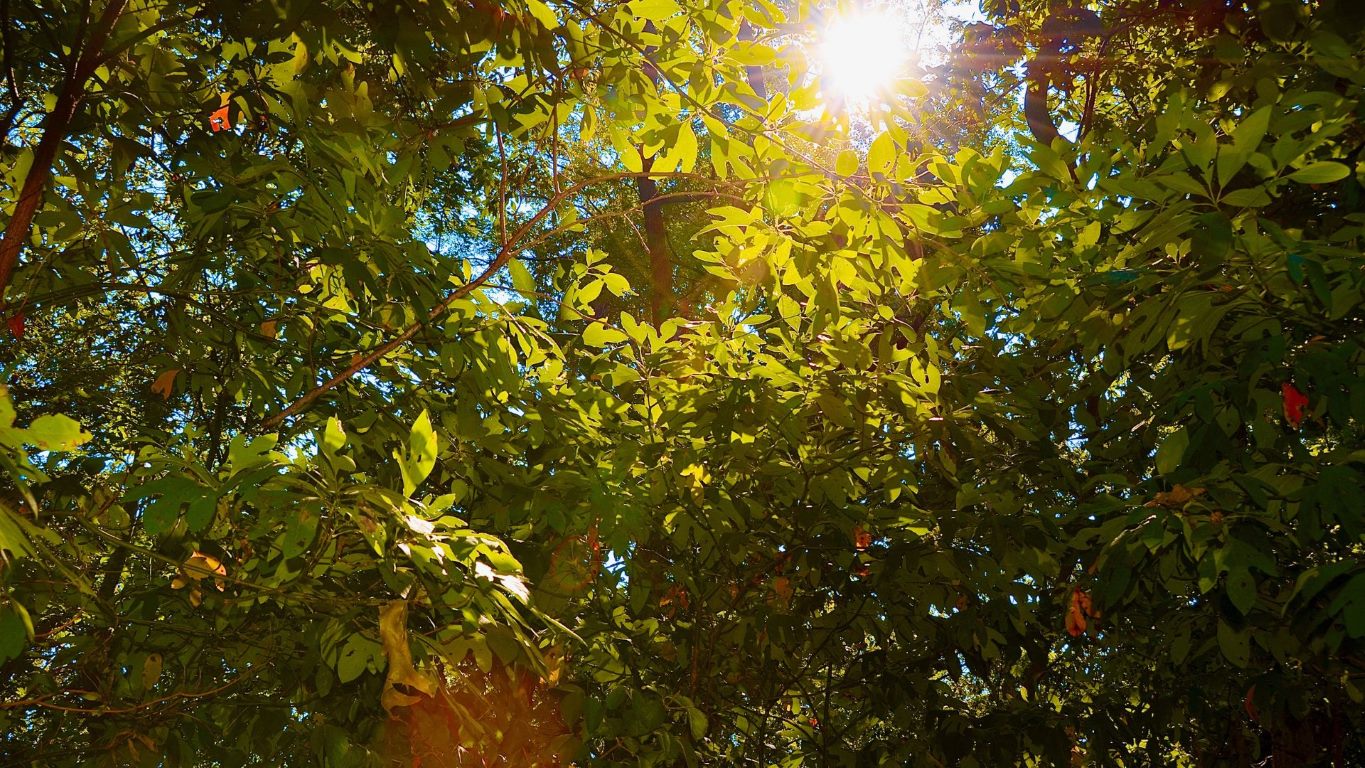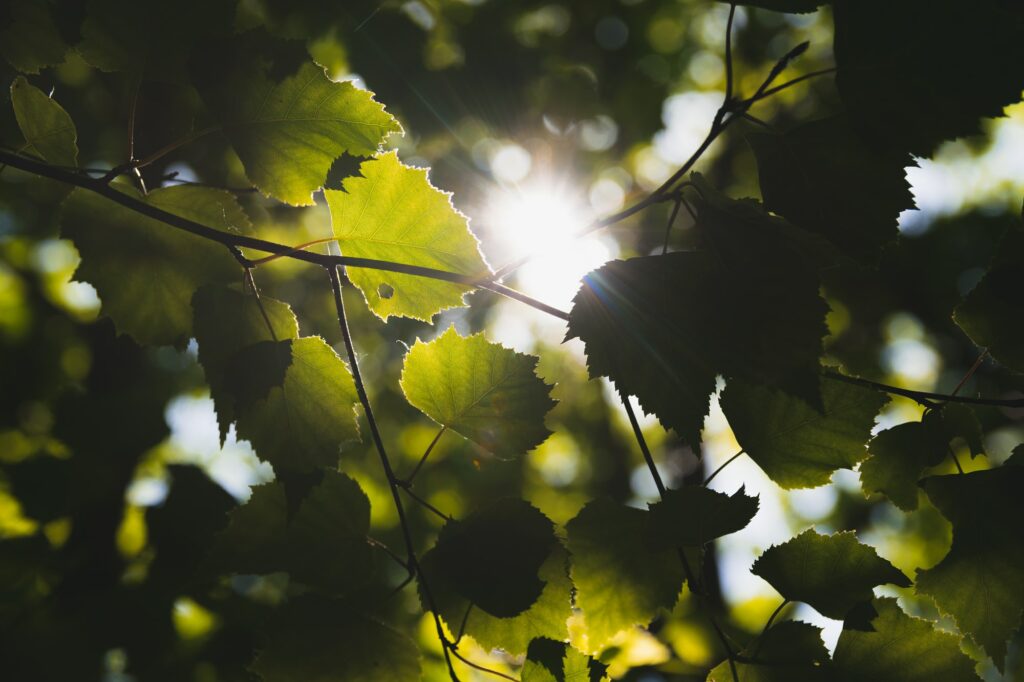
Sun leaves, and shade leaves are both built differently. Sun leaves are thicker and will contain more photosynthetic material. Shade leaves have a large surface area to take advantage of sporadic sunlight.
This article will describe the difference between the two types of leaves. I’ll then cover whether trees have both types of leaves or not. I’ll finish with some things to consider when managing trees.
Characteristics of a Sun Leaf
Sun leaves are designed to deal with high levels of light. High levels of light mean high levels of energy. Sun leaves tend to be thicker and densely packed with photosynthetic material. All this photosynthetic material helps the leaf process all the extra energy.
You will find sun leaves on the outer canopy of a tree. These leaves will get the full sun, giving them lots of solar energy.
Additional Layers of Palisade Mesophyll
Sun leaves have two or three layers of palisade mesophyll, making them thicker than shade leaves.
Palisade mesophyll are column-like cells inside a leaf. These cells sit right below the upper epidermis.
To help me remember some of these terms, I like to research the word’s etymology. Usually, the name derives from an ancient word that describes the characteristics. The etymology for palisade mesophyll is:
- Palisade = From the Latin word palis, meaning ‘stake’. If you refer to the picture above, these cells look like a row of stakes.
- Mesophyll = From the Greek words meso, meaning ‘middle’. And phullon, meaning ‘leaf’
So, palisade mesophyll refers to the stake-like cells in the middle of a leaf.
The palisade layer of a leaf is where photosynthesis happens. Inside the palisade mesophyll are chloroplasts. Chloroplasts contain chlorophyll, a green pigment that absorbs light energy from the sun.
The leaf will have more chloroplasts per inch of surface area by adding layers of palisade mesophyll. The leaf now has a higher density of chloroplasts.
By having higher levels of chloroplasts, a leaf will have a higher rate of photosynthesis. This is perfect for a sun leaf, as it will receive much more light than a shade leaf.
If a leaf doesn’t adapt to higher sun levels, problems can start to occur. The solar radiation can damage the leaf. So, sunlight isn’t always a good thing. There are several other factors that affect photosynthesis. Learn more here.

Small but Thicker Leaves
Sun leaves tend to be smaller than shade leaves. However, sun leaves can be up to 50% thicker than shade leaves. Sun leaves don’t need a large surface area as they don’t need to compete for sunlight.
As mentioned earlier, this increased thickness is due to the additional layers of palisade mesophyll. So, a sun leaf will be smaller but have a higher density of photosynthetic material.
Deeper Leaf Lobes
Not all trees have lobed leaves, but the ones that do will have deeper lobes on the sun leaves.
Lobed – (of a leaf) having rounded or pointed parts that stick out from the main part. Cambridge Dictionary
There are two main reasons for deeper lobes on sun leaves:
- It allows light through to the shade leaves
- Keeps the leaf cooler
Allows Light Through
By having deeper lobes, the light will shine through to the shade leaves. This way, the sun leaves don’t hog all the light.
So, a sun leaf will take up less room by being smaller. It will also have much deeper lobes (if the leaf has lobes). Now, plenty of light will be able to shine through the whole canopy.
Keeps the Leaf Cooler
Sun leaves face the full brunt of the sun, so they heat up quicker. Photosynthetic rates reach their peak around 77F. At around 104F, damaging compounds will release, hurting the tree.
Leaves with deeper lobes have lower average and peak temperatures. This is because deeper lobes can get rid of heat more efficiently.
Characteristics of a Shade Leaf
Shade leaves are built for efficiency. They don’t receive much light, so they need to make the most of every opportunity.
Shade leaves are located on the inner canopy of a tree. They receive sunlight through the canopy. As the sunlight filters through the rest of the canopy, shade leaves will receive less sunlight.
At this point, it would be easy to say, “A shade leaf is built the opposite way of a sun leaf’.” But, let’s understand the why.
One Layer of Palisade Mesophyll
Shade leaves only need one layer of palisade mesophyll. These leaves don’t receive enough light to justify extra photosynthetic material.
Shade leaves are more efficient at photosynthesizing despite not having as much mesophyll. The chlorophyll inside the mesophyll adapts to low-light conditions.
Another advantage to having less mesophyll is the cost to make the leaf. Shade leaves are thinner and cheaper to produce. This means a tree doesn’t have to dedicate as much energy to making or repairing shade leaves.
Fewer Carotenoids Produced
Carotenoids are yellow, red, or orange pigments that a tree produces. These pigments assist in the process of photosynthesis and also help protect the leaf from damage.
Leaves can’t keep absorbing light. There comes the point when there’s too much light, and photosynthetic rates start to drop. This is called the light saturation point.
Any excess sunlight can damage the leaf once the light saturation point is reached. Different species have different tolerances. Also, sun leaves will have a higher light saturation point than shade leaves.
The leaf needs to get rid of this excess light energy before it starts to cause damage. Carotenoids are one solution. Carotenoids will help dissipate light energy. This process can help protect the leaf from damage in extreme conditions.
Shade leaves aren’t overexposed to the sun; they don’t need as many carotenoids. The carotenoids are better off in the sun leaves, where the carotenoids will get more use.
Shade Leaves Have a Larger Surface Area
Shade leaves have a large surface area. This is due to the low levels of light that filter through the canopy. With a larger surface area, the leaf will have a better chance of picking up stray bits of light.
Do All Trees Have Sun and Shade Leaves?
It’s common for larger trees to have both sun and shade leaves, but it isn’t always the case. A tree can have only sun or only shade leaves.
Sun and Shade Leafed Trees
Most trees have a combination of sun and shade leaves. This is due to canopy size and light movement throughout the day.
Trees with both types of leaves will do better in highlight environments. These trees do better due to the different leaf types working together.
Sun leaves will reach their light saturation point much earlier. Once this point is hit, the photosynthetic rates will drop. But, the light will still travel through the canopy to the shade leaves. The shade leaves will not have reached their light saturation point. This means photosynthesis can still occur, despite the sun leaves being at their photosynthetic limit.
Only Sun Leaves On a Tree
It’s rare, but some trees will only produce sun leaves. These trees will receive lots of sunlight throughout the day. Also, these trees will have a sparse open canopy. There’s little chance for the outer canopy to shade the inner canopy with a sparse canopy. Therefore, all leaves will be sun leaves.
Only Shade Leaves On a Tree
Again, having only shade leaves on a tree tends to be rare. Shade-only trees can be found in dense forests. Smaller trees that sit under the canopy of the forest giants may only produce shade leaves. These trees get by with minimal light.
Considerations For Managing Trees
There are two things to consider regarding tree management and different leaf types—the light intensity changing for a tree and the light intensity changing for sections of trees.
It’s more common for a shaded tree to be exposed to a higher intensity of sunlight. This can happen when a tree or building is removed. A tree living in the shade will struggle if that shade is removed.
So, if you are removing a large tree, take note of the tree’s surroundings. Do you need to monitor any surrounding trees?
Are you attending to a tree showing signs of sun damage? Look around. Has a larger tree recently been removed? Has a building been recently demolished?
It’s rare, but a tree living in full sun can end up living in full shade. This can happen when planting trees.
A juvenile tree living in a nursery can be sitting in the sun. Then, someone plants the same tree in the shade. The tree will struggle as its leaves have adapted to the full sun. The leaves won’t be efficient enough to make energy from the limited sunlight.
It’s also important to be careful when pruning trees. Taking too much off the outer canopy can expose the inner canopy to intense sun. Again, these shade leaves won’t be ready for the sudden change in light. Damage may occur.
With all that considered, deciduous trees adapt to light changes better. Deciduous trees need to regrow their leaves each year; the new growth can adapt to the conditions.
